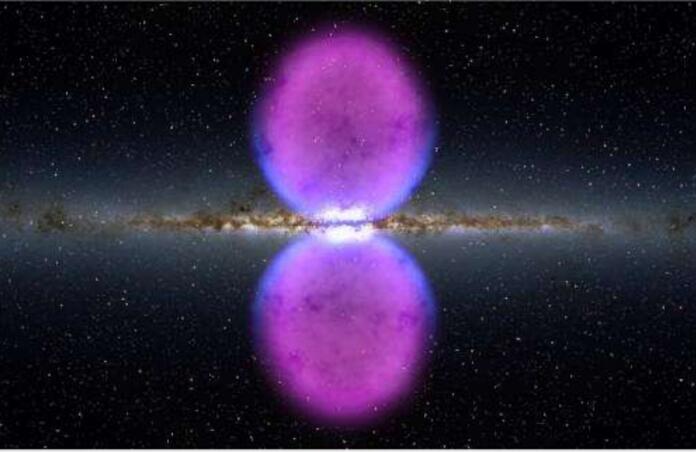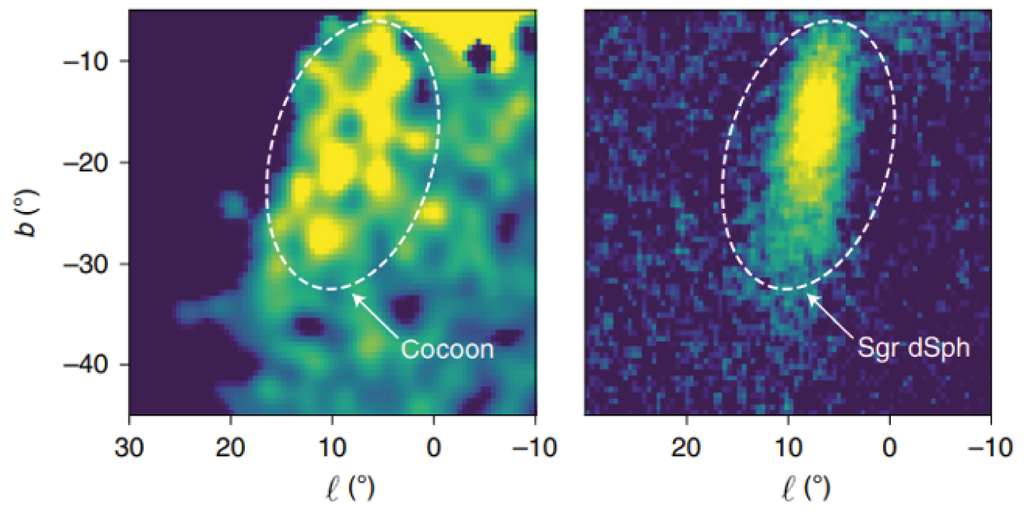Gamma Radiation in Fermi Bubbles found to Originate from Dwarf Satellite Galaxy

Much of the search for dark matter is focused on the centre of the milky way due to enigmatic structures known as the Fermi bubbles. These, discovered all the way back in 2010, are colossal gaseous structures emanating from the core of Sarittarius A*. What makes these so puzzling is a substructure found within the bubbles, known as the Fermi cocoon. This region appeared to be a heavy emitter of Gamma-Radiation, despite it not housing a stellar nursery or other visible mechanisms to do so. This led researchers to postulate that the source may be the mutual annihilation of dark matter particles and antiparticles.
In a paper published on the 5th of September, a team led by Roland Crocker noticed that the Fermi cocoon is shaped and oriented similarly to a satellite galaxy of the milky way, the Sarittarius Spheroidal Dwarf Galaxy (Sgr dSph). Additionally, the two targets were collinear, a random event with a probability of well below 1%, according to the paper, leading them to investigate whether the Sgr dSph may be the true source of the gamma rays.

the alignment and orientation of the Fermi cocoon and the Sagittarius Dwarf Galaxy.
While the galaxy too is dormant in terms of star formation, due to being tidally stripped by the milky way, the paper outlines convincing evidence that millisecond pulsars within the dwarf galaxy could supply the observed radiation. These are neutrons stars which rotate at incredibly fast speeds, specifically within millisecond time periods. Their intense magnetic fields channel material and radiation to be ejected in two jets from the poles of the star.
To test this, the team made use of images from the Fermi Gamma-ray Telescope. By contrasting various fitting models comparing these to a baseline model that identifies only conclusive sources of gamma radiation, within their region of interest. Doing this, their template which included Sgr dSph as a source was favoured over alternatives with 8.1 standard deviations. The paper further outlines
Having shown the origin of these rays to be from Sgr dSph, the team next endeavoured to identify their source. The first ruled out candidate was a diffused source of gamma rays produced by collisions between cosmic rays and interstellar material. This could not be the case, since Sgr dSph lacked sufficient material to allow for these collisions to occur on a scale as observed. Secondly, the ruled out stellar gamma ray emission as, once again, this could not account for the all the emission observed. Finally, they disfavoured the dark matter annihilation approach, since according to their n-body simulations, which model the motion of particles, the dark matter halo of Sgr dSph would have been dispersed by the tidal destruction of the dwarf galaxy.
This left them with the assumption that the source was due to abundant millisecond pulsars present within Sgr dSph. While this approach also led to a few challenges, namely significantly higher luminosities than similar structures as well as uncharacteristic spectral wavelength distributions. This argument was addressed by accounting for the unique stellar populations and environment of Sgr dSph. The current stars visible in the galaxy are younger and metal poor in comparison to similar systems, and thus are expected to produce more pulsars per stellar mass, while each is also brighter than similar stars that are older. As for the environment, the absence of any significant wind nebulae or supernova remnants makes photons more susceptible to inverse Compton scattering, amending the expected wavelength distribution to match what is observed.
With that, the study concludes that the gamma source is indeed due to millisecond pulsars within Sgr dSph, forcing further dark matter searches to reassess their chosen regions, such as the galactic centre or other dwarf galaxies.
--
Cover Image: NASA's Goddard Space Flight Center
Journal Source: R. Crocker et al, Gamma-ray emission from the Sagittarius dwarf spheroidal galaxy due to millisecond pulsars, Nature Astronomy, 2022
